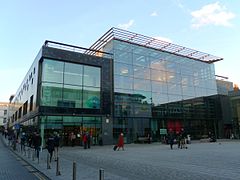Jubilee Library, Brighton

The library from the southwest
|
|
| Country | United Kingdom |
|---|---|
| Type | Public library |
| Established | 2005 |
| Location | Jubilee Square, Brighton |
| Coordinates | 50°49′31″N 0°08′18″W / 50.8252°N 0.1383°WCoordinates: 50°49′31″N 0°08′18″W / 50.8252°N 0.1383°W |
| Branch of | Brighton & Hove Libraries |
| Collection | |
| Size | 176,000 (standard); 45,000 (Rare Books collection) |
| Access and use | |
| Access requirements | None |
| Population served | 141,600 |
| Other information | |
| Director | Sally McMahon (Head of Libraries) |
| Website | Jubilee Library Home Page |
| References: | |
Jubilee Library is the main public library serving the English city of Brighton and Hove. It forms the centrepiece of the Jubilee Square development in central Brighton—a £50 million scheme to regenerate a 40-year-old brownfield site. Opened in 2005 by the Princess Royal and subsequently visited by Queen Elizabeth II, the library has won many design awards and has been described as "a triumph", "the most important public building constructed in Brighton since the Royal Pavilion" and "the superhero [that] saved the city". In terms of visitor numbers and loans, the library is one of the busiest in England.
Before 2005, the seaside resort of Brighton did not have a purpose-built central library, but there had been attempts to create one for more than a century. After several proposals in the postwar period came to nothing—including elaborate schemes which would have combined a library with ice rinks, exhibition halls, car parks and other developments—funding was secured in the late 1990s through the newly introduced Private finance initiative. A suitable derelict site already existed in the centre of Brighton, and a competitive tender process identified finance providers, architects and building contractors. The new library, the first part of the Jubilee Square scheme to be finished, was ready on time and on budget in 2005, and superseded a temporary library which had replaced the 100-year-old facilities in 1999.
The new library brings together facilities previously housed in separate sites, and offers extensive IT facilities, a large LGBT literature collection and various social and community activities. Several pieces of art were commissioned for the building and its environs. The building has been described as one of the most energy-efficient structures in England—its carbon footprint is half that of a traditional public building of comparable size, and natural energy is used throughout.
Brighton, now part of the city of Brighton and Hove, developed as a high-class seaside resort in the 18th and 19th centuries. Private and subscription libraries were quick to appear: they catered for rich visitors and performed a secondary function as fashionable social venues. The first, on Old Steine, opened in 1760 and survived until 1856. Others had thousands of volumes in stock.
...
Wikipedia
